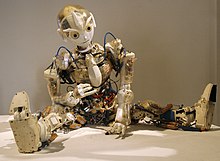Personal Robot

A personal robot (short PR , English for "personal robot" or "private robot") is a mechatronic system with one or more microcomputers . In contrast to an industrial robot , the personal robot can act in its environment, with it and / or with people and other personal robots z. B. communicate and interact in networks. Personal Robots can be operated, used and controlled by a single person.
background
A division into publicly used personal robots z. B. service robots and personal robots z. B. Toy robots , like personal computers , make sense. Due to the completed construction of the PR, these machines function largely independently, autonomously and independently. The personal robots are increasingly capable of learning. Multiple interfaces enable communication in networks. So with other robots, computers, etc. Personal robots react with their sensors to external influences such as B. touches, tones, sounds, visual changes, etc. Personal Robots store data and information. Acquired experiences influence them and so the PRs use this knowledge to implement their further actions. Transforming a robot like ASIMO into a general purpose private robot or an artificial servant is primarily a software problem. With the current state of the art, extensive advances in motion planning , image understanding (especially the environment recognition), language understanding and machine reasoning are indispensable in order to pull this vision into the realm of the possible.
The assistance robot FRIEND , which was developed at the Institute for Automation Technology at the University of Bremen, is intended to support disabled and elderly people in the activities of daily life (e.g. preparing a meal) and enable them to reintegrate into professional life. It carries out tasks started by the user autonomously and perceives its surroundings through a large number of sensors and independently detects objects that are to be gripped.
literature
- Nelson Winkless: If I Had a Robot: What to Expect from the Personal Robot . Dilithium Press, US, Beaverton 1984, ISBN 978-0-88056-353-6 .
- Manja Lohse: User-friendly human-robot interaction: criteria for the design of personal service robots . Vdm Verlag Dr. Müller, Saarbrücken 2007, ISBN 978-3-8364-1923-9 .
Individual evidence
- ↑ Martens, C., Prenzel, O., Gräser, A .: The Rehabilitation Robots FRIEND-I & II: Daily Life Independency through Semi-Autonomous Task-Execution . In: I-Tech Education and Publishing . , Vienna, Austria2007, pp. 137-162. ISBN 978-3-902613-04-2 .
- ↑ Ivlev, O., Martens, C., Gräser, A .: Rehabilitation Robots FRIEND-I and FRIEND-II with the dexterous lightweight manipulator . In: Restoration of Wheeled Mobility in SCI Rehabilitation . 17, 2005.
- ↑ Volosyak, I., Ivlev, O., Gräser, A .: Rehabilitation robot FRIEND II - the general concept and current implementation . In: Proc. 9th International Conference on Rehabilitation Robotics ICORR 2005 . 2005, pp. 540-544.
